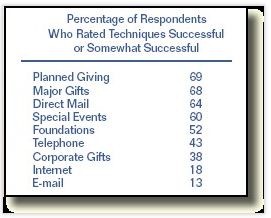A report recently released by The Center on Philanthropy at Indiana University indicates that planned giving is the most effective form of fundraising in today’s environment. The “Philanthropic Giving Index” for December 2002 was sponsored in part by The Association of Fundraising Professionals (AFP) and The Association for Healthcare Philanthropy (AHP). The report summarizes the findings of a survey of a representative selection of nonprofits and consultants chosen to represent a cross section of the nonprofit sector.
Overall, respondents were less optimistic than in the past about prospects for success in fundraising in the current environment. The philanthropic giving index (PGI) was 77.7 in December 2002, the lowest level since the index was first published and down significantly from its peak of 94.6 in December 1999. Despite current pessimism, however, respondents were much more optimistic about prospects for the next six months with an Expectations Index (EI) of 85.8.
The survey sheds significant light on the impact of the events of September 11th and indicates that current economic conditions appear to be having a more negative impact on expectations for giving, as the PGI is now lower than it was in the wake of the events of the fall of 2001.
Importance of planned giving

Other findings of the report are important for those responsible for planned gift development efforts for their organizations and institutions. When asked what fundraising techniques were most successful in today’s environment, more development executives surveyed rated planned giving and major gifts as the most successful methods, followed closely by direct mail and special events.
The findings varied somewhat depending on the type of organization, its size, and the scope of its activities. Those sectors that reported the most reliance on the success of planned and major gift efforts were education, religion, healthcare, human services, and public benefit/environmental causes.
National and regionally based organizations reported the most success with planned giving as a source of funding, while those more locally based were somewhat less optimistic about this funding methodology.
Overall, organizations in the under $1 million revenue range, the $1 million to $10 million range, and the over $10 million group all reported that planned giving was currently among the most successful fundraising techniques they currently employ.
There are a number of reasons why planned giving is a resilient source of income during difficult economic periods:
In times of economic dislocation, concerns about outliving resources and other economic risks referred to in the article on page one are increased.
The gift planning tools that help deal with economic concerns may thus be of greater interest.
Older donors who utilize planned gifts in larger numbers are normally retired and thus not concerned about losing their jobs.
Retirees are, however, more interested in gifts that feature retained income in times of lower interest rates and dividends.
Major donors who would make outright gifts during times of greater affluence or optimism may be more likely to consider certain types of planned gifts such as term of years trusts and lead trusts that allow them to make significant gifts over a longer period than might otherwise be the case.
Planned gifts offer those who still have significant amounts of appreciated assets to lock in their gains in a way that does not require further losses in the form of capital gains taxes.
Carefully managing the increased interest in planned gifts among donors can help assure that the maximum benefits accrue to your organization in the shortest period of time.

It is vital to make certain that the right gift opportunities are exposed to the right segment of donors at the appropriate point in their natural lifecycle of giving. There are many ways to give where the gift is not completed immediately, but where benefits are not necessarily deferred until the death of relatively young persons.
The Indiana University Center on Philanthropy giving index is a valuable tool that can serve to guide nonprofit executives in focusing their efforts where they may be most effective at a given point in time. The Philanthropic Giving Index now indicates that it may be especially prudent to make sure that efforts to encourage planned gifts are in place and positioned to provide maximum funding for your institution in an efficient and cost-effective manner.
This report is the latest information that indicates that planned giving is to some extent countercyclical and may hold greater importance during challenging economic periods. See “Philanthropy in Uncertain Times,” published in Trusts & Estates magazine in March 2002 and available in full at www.sharpenet.com/current.
For more information and a link to the complete Center on Philanthropy at Indiana University report, visit our Web site at www.sharpenet.com/current.

